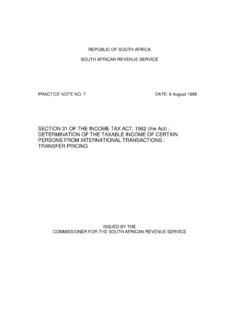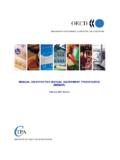Transcription of CFM95000 Interest restriction: Contents - GOV.UK
1 1 26 February 2018 This guidance reflects the legislation as amended by Finance ( ) Bill 2017-19, which at the time of publication in February 2018 had not received royal assent. CFM95000 Interest restriction: Contents CFM95100 Interest restriction: Overview: Contents CFM95200 Interest restriction: Core rules: Contents CFM95300 Interest restriction: Groups, periods and financial statements: Contents CFM95600 Interest restriction: Tax- Interest : Contents CFM95700 Interest restriction: Tax-EBITDA: Contents CFM95900 Interest restriction: Group- Interest : Contents CFM96200 Interest restriction: Related parties: Contents CFM96400 Interest restriction: Group-EBITDA: Contents CFM96600 Interest restriction: Alternative calculation: Contents CFM96700 Interest restriction: Joint Ventures: Contents CFM97100 Interest restriction: Public Infrastructure.
2 Contents CFM97500 Interest restriction: Banking and insurance groups: Contents CFM97700 Interest restriction: Property and REITs: Contents CFM97800 Interest restriction: Leasing: Contents 2 CFM98000 Interest restriction: Anti-avoidance: Contents CFM98200 Interest restriction: Carry forward rules: Contents CFM98300 Interest restriction: Commencement Rules: Contents CFM98400 Interest restriction: Administration: Contents CFM95190 Glossary of Terms 3 CFM95100 Interest restriction: Overview: Contents CFM95110 Interest restriction: Overview: Introduction CFM95120 Interest restriction: Overview: Policy background CFM95130 Interest restriction: Overview: OECD Action 4 CFM95140 Interest restriction: Overview: A short guide CFM95150 Interest restriction: Overview: Structure of the legislation 4 CFM95110 Interest restriction: Overview: Introduction What is it?
3 The Corporate Interest Restriction (TIOPA10/PART10 and SCH7A) was introduced in FA ( ) 2017. The aim of the rules is to restrict a group's deductions for Interest expense and other financing costs to an amount which is commensurate with its activities taxed in the UK, taking account how much the group borrows from third parties. Amounts that are disallowed in one accounting period may be carried forward and may potentially be deducted in a subsequent period. Who is affected? The rules apply to all companies within the charge to corporation tax. However, groups with less than 2 million of net Interest expense and other financing costs per annum will not suffer any restriction. Beyond taking reasonable care to establish that this is the case, companies in such groups are not affected by the rules.
4 They have no reporting requirements, though they can appoint a reporting company and file an Interest Restriction Return if they wish to. When does it apply? The rules apply to periods of account starting on or after 1 April 2017. Periods of account straddling 1 April 2017 are treated as two notional periods. A notional period ending 31 March 2017 is subject to Part 7 of TIOPA 2010, commonly known as the World-Wide Debt Cap (WWDC). Only the notional period commencing 1 April 2017 is subject to the Corporate Interest Restriction. 5 CFM95120 Interest restriction: Overview: Policy background Most multi-national groups have external borrowings on which they pay Interest and other financing costs.
5 The borrowings will range from multi-billion syndicated loans used to finance a major acquisition or takeover, to overdraft facilities used to help manage the cash flows of individual companies within the group. As well as external borrowings, a multi-national group will very often have borrowing arrangements between group companies. In line with Action 4 of the organisation for economic Cooperation and development 's work on Base Erosion and Profit Shifting, the Corporate Interest Restriction legislation has been designed to combat attempts by multinational enterprises (MNEs) and other companies to obtain excessive tax relief for net Interest and similar financing costs. The aim of these new rules is to ensure relief on financing costs is commensurate with the extent to which a business's activities are subject to corporation tax.
6 6 CFM95130 Interest restriction: Overview: OECD Action 4 Action 4 of the organisation for economic Cooperation and development (OECD) Base Erosion and Profit Shifting (BEPS) Project addressed "Limiting Base Erosion Involving Interest Deductions and Other Financial Payments". The BEPS project was a major and wide ranging initiative by the OECD and G20 countries to limit tax base erosion and the shifting of profits in such a way that they would bear little or no taxation. The first output from this initiative was the publication of the report "Addressing Base Erosion and Profit Shifting" in February 2013. This was followed by a 15-point Action Plan, adopted in September 2013. One of those actions concerned hybrid mismatches and the UK brought into effect legislation to address these issues in the Hybrid and Other Mismatches legislation (TIOPA10/PART6A), applicable from 1 January 2017.
7 The OECD report on Action 4 was published in interim form in 2014 and in final form in October 2015. Further technical work was conducted on specific areas during 2016 and an updated report was issued in December 2016. By 2016, the focus of the BEPS project had shifted to implementation. The BEPS package as a whole is designed to be implemented via changes in domestic law and practices, and via treaty provisions. Action 4 requires enactment in domestic law. The report put forward extensive best practice recommendations. The Executive Summary of the Action 4 Report begins as follows: "It is an empirical matter of fact that money is mobile and fungible. Thus, multinational groups may achieve favourable tax results by adjusting the amount of debt in a group entity.
8 The influence of tax rules on the location of debt within multinational groups has been established in a number of academic studies and it is well known that groups can easily multiply the level of debt at the level of individual group entities via intragroup financing. Financial instruments can also be used to make payments which are economically equivalent to Interest but have a different legal form, therefore escaping restrictions on the deductibility of Interest . Base Erosion and Profit Shifting (BEPS) risks in this area may arise in three basic scenarios: Groups placing higher levels of third party debt in high tax countries. Groups using intragroup loans to generate Interest deductions in excess of the group s actual third party Interest expense.
9 7 Groups using third party or intragroup financing to fund the generation of tax exempt income." This clearly sets out the issues covered by the report. The best-practice recommendations in the report include a number of specific elements, some of which are necessary to implement with the recommended approach and some of which are optional. The key components are: a "fixed-ratio" rule that limits deductions for Interest and payments economically equivalent to Interest to a fixed percentage of earnings before Interest , taxes, depreciation and amortisation (EBITDA); and an optional group ratio that would allow a higher ratio of financing expense to EBITDA where groups are highly leveraged with third party debt for non-tax reasons.
10 Certain other features are allowed to reduce the impact of the provisions on entities that pose less BEPS risk. These include the following. A de minimis threshold: a level of Interest expense below which the provisions would not apply. An exclusion for Interest paid to third party lenders on loans used to fund public benefit projects, subject to conditions. In these circumstances, although an entity might be highly leveraged, the BEPS risk is considered to be reduced due to the nature of the projects and the close link to the public sector. The carry-forward of disallowed Interest expense and/or unused Interest capacity (where an entity s actual net Interest deductions are below the maximum permitted) for use in future years.












